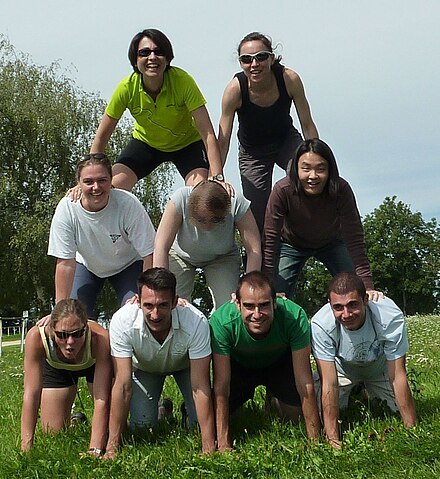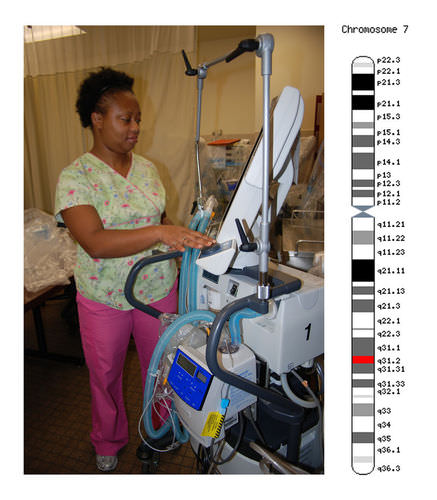10.33 Hardy-Weinberg模型 -- -- 高级
章节大纲
-
Why is balance important?
::为什么平衡很重要?To these individuals, the importance of maintaining balance is obvious. If balance, or equilibrium, is maintained within a population's genes , can evolution occur? No. But maintaining this type of balance today is difficult.
::对这些人来说,保持平衡的重要性是显而易见的。 如果平衡或平衡在人口基因中得以维持,那么进化能否发生? 不。 但今天维持这种平衡是困难的。Populations at Equilibrium: The Hardy-Weinberg Model
::平衡中的人口:哈迪-温伯格模型Like and Wallace , who independently developed similar ideas about evolution and , mathematician Godfrey Hardy and physician Wilhelm Weinberg independently developed a model of at equilibrium. The Hardy-Weinberg model (sometimes called a law) states that a population will remain at genetic equilibrium - with constant and genotype frequencies and no evolution - as long as five conditions are met:
::华莱士(Wallace)独立地提出了关于进化的类似想法,而数学家戈弗雷·哈代(Godfrey Hardy)和医生威廉·温伯格(Wilhelm Weinberg)独立地制定了平衡模式。 哈迪-温伯格模式(有时称为法律 ) 指出, 只要满足五个条件,人口将保持基因平衡 — — 保持恒定和基因型频率,没有进化 — — 只要满足五个条件:-
No
.
::没有。 -
No
.
::没有。 -
Very large
population size
.
::人口规模很大。 -
Random
mating
.
::随机交配 -
No natural selection.
::没有自然选择。
We will consider the above in more detail in later sections of the concept because deviations from these conditions are the causes of evolutionary change. For now, let’s look more closely at the Hardy-Weinberg equilibrium model. We’ll use another hypothetical rabbit population to make the model concrete: 9 albino rabbits and 91 brown rabbits (49 homozygous and 42 heterozygous). The gene pool contains 140 B alleles and 60 b alleles – gene frequencies of 0.7 and 0.3, respectively. The Figure summarizes the data for this parent population.
::在概念的后面部分,我们将更详细地考虑上述情况,因为偏离这些条件是进化变化的原因。 现在,让我们更仔细地看看哈迪-温伯格平衡模型。 我们将利用另一个假设的兔子群来将模型具体化:9只白化兔子和91只棕色兔子(49只同源虫和42只异源虫 ) 。 基因库中包含140只B Alteles和60只beles — — 基因频率分别为0.7和0.3。 图中总结了这一父母群体的数据。The coat color gene pool for a hypothetical rabbit population includes two alleles. Genotype and allele frequencies are calculated given the number of individuals having each of the three possible genotypes. If we assume that alleles sort independently and segregate randomly as and eggs form, and we also assume that mating and are random, then the that an offspring will receive a particular allele from the gene pool is identical to the frequency of that allele in the population. A ( Figure ) using these frequencies predicts the probability of each genotype (and phenotype) in the next generation:
::如果我们假设所有细胞都独立地分类,随机地分离成卵状, 我们也假设交配和随机性, 那么一个后代将从基因库中接收一个特殊的异象 与该异象在人群中的频率相同。 A (图 ) 使用这些频率预测下一代中每个基因型( 和 苯型) 的概率 :A Punnett Square predicts the probability of each genotype and phenotype for the offspring of the population described in the Figure. Row A summarizes the frequencies of each genotype among offspring, and row B calculates allele frequencies for the next generation. Comparing these to the parent generation shows that the gene pool remains constant. The population is stable; it is at a Hardy-Weinberg equilibrium. If we calculate the frequency of genotypes among the offspring predicted by the Punnett square, we see that they are identical to the genotype frequencies of the parents. Allele frequency remains constant as well. The population is stable – at a Hardy-Weinberg genetic equilibrium.
::如果我们计算Punnett 广场预测的后代基因型的频率,我们就会发现它们与父母的基因型频率相同。 阿列斯频率也保持不变。 人口稳定 — — 在哈迪温贝格遗传平衡下。A useful equation generalizes the calculations we’ve just completed. The variables are as follows: p = the frequency of one allele (we’ll use allele B here) and q = the frequency of the second allele ( b , in this example). We will use only two alleles, but similar, valid equations can be written for more alleles.
::一个有用的方程式概括了我们刚刚完成的计算。 变量如下: p = 一个 allele的频率( 我们在这里使用 Altele B ) , q = 第二个 allele 的频率( 在这个例子中, b ) 。 我们将只使用两个等式, 但对于更多的 allele 来说, 也可以写出类似的有效方程式 。Recall that the allele frequency equals the probability of any particular gamete receiving that allele. Therefore, when egg and sperm combine, the probability of any genotype (as in the Punnett square above) is the product of the probabilities of the alleles in that genotype:
::提醒大家注意, 异位频率等于任何特定的调子接收该调子的概率。 因此, 当蛋和精子结合时, 任何基因型的概率( 如上面的 Punnett 方块) 是该基因型中的异位数概率的产物 :-
Probability of genotype
BB
=
p
X
p
=
p
2
.
::基因型BB = p X p = p2 的概率。 -
Probability of genotype
Bb
= (
p
X
q
) + (
q
X
p
) =
2 pq
.
::基因型Bb = (p X q) + (q X p) = 2 pq 的概率。 -
Probability of genotype
bb
=
q
X
q
=
q
2
.
::基因型bbb 的概率= q X q q = q2。
We have included all possible genotypes, so the probabilities must add to 1.0. Our equation becomes this:
::我们已经包括了所有可能的基因型, 因此概率必须增加到1.0。我们的等式变成:p 2 + 2 pq + q 2 = 1 frequency of genotype BB frequency of genotype Bb frequency of genotype bb This is the Hardy-Weinberg equation, which describes the relationship between allele frequencies and genotype frequencies for a population at equilibrium.
::这是Hardy-Weinberg等式,它描述了在平衡时人口在Allee频率和基因型频率之间的关系。Cystic Fibrosis
::Cystic 纤维化The equation can be used to determine genotype frequencies if allele frequencies are known or allele frequencies if genotype frequencies are known. Let’s use a common human genetic disease as an example. Cystic fibrosis (CF) is caused by a recessive allele ( f ) which makes a non-functional chloride ion channel , leading to excessive mucus in the lungs , inadequate secretion by the pancreas , and early death.
::该等式可以用来确定基因类型频率,如果已知所有频率,则可以用来确定基因类型频率,如果已知所有频率。 让我们以普通人类遗传疾病为例。 细胞纤维化(CF)是由一个不起作用的氯化电离通道(f)造成的,导致肺部出现过量的粘结,胰腺分泌不足,以及过早死亡。Cystic fibrosis is an inherited disease of the lungs and pancreas. A recessive allele of a gene located on chromosome 7 (the gene locus is colored red, right), which codes for a chloride ion channel, causes the disease. Treatment includes using a ventilator (left) and antibiotic therapy. Knowing that 1 in every 3,900 children in the United States is born with CF, we can use the Hardy-Weinberg equation to ask what proportion of the population unknowingly carries the allele for cystic fibrosis. An individual who has CF must have the genotype ff , because the allele is recessive . Using the value for the frequency of the homozygous recessive genotype, we can calculate q, the frequency of the recessive allele, f:
::由于知道美国每3 900名儿童中就有1名是CF出生的,我们可以使用Hardy-Weinberg等式来询问在不知不觉中携带细胞纤维化异象的人口比例。 拥有CF的人必须具有基因型ffff , 因为Altele是休眠的。 我们可以使用同质休眠基因型的频率值来计算q, 休眠异象的频率, f:1/3900 = 0.0002564 = frequency of ff genotypes = q 2
::1/3900 = 0.002564 = yff 基因型频率 = q2To find q , the frequency of allele f , we must take the square root of the frequency of ff genotypes: q = √0.0002564 = 0.016 = frequency of the f allele. Because p + q = 1 (the sum of the frequency of allele f and the frequency of allele F must equal 1.0), p = 1 – q = 1.0 – 0.0160 = 0.9840 = frequency of the F allele.
::要找到 q, elele f 的频率, 我们必须从 ff genotype 频率的平方根 : q = 0.0002564 = 0.016 = fele 频率的频率。 因为 p+q = 1 ( ele f 频率和 alle F 频率的总和必须等于 1. 0), p = 1 - q = 1.0 - 0.0160 = 0.9840 = Fele 频率 。According to the Hardy-Weinberg equation, for a population at equilibrium the frequency of carrier genotypes, Ff , is 2pq = 2 X 0.016 X 0.984 = 0.0315 .
::根据Hardy-Weinberg等式,对于平衡的人口,载体基因型Ff的频率为2pq = 2 X 0.016 X 0.984 = 0.0315。In other words, if the population is indeed at equilibrium for this gene, just over 3% of the population carries the recessive allele for cystic fibrosis. Of course, this calculation holds true only if the US population meets the five conditions we listed at the beginning of this section. In nature, populations seldom satisfy all five criteria. Let’s consider how well each condition describes the US population for the cystic fibrosis gene:
::换句话说,如果人口确实处于该基因的平衡状态,则只有3%以上的人口拥有细胞纤维化的消退异差。 当然,这一计算只有在美国人口符合我们在这部分开头列出的五个条件的情况下才能维持。 在自然界,人口很少能满足所有五个标准。 让我们想想每个条件对美国人口如何描述囊肿纤维化基因:Very Large Population Size
::人口规模非常大Although the equation ideally describes an infinitely large population – never found in nature, of course – the US population is probably large enough that this condition alone does not significantly disrupt equilibrium.
::尽管这个等式理想地描述了无限大的人口 — — 当然,在自然界中从未找到 — — 美国人口可能足够大,仅凭这个条件不会大大扰乱平衡。No Mutation
::无变异Mutations happen constantly, if at a low rate, so “no mutation” is a second unrealistic condition. However, mutations affecting any one particular gene are rare, so their effect on an otherwise large, stable population is small.
::突变经常发生,如果低速,那么“无突变”是第二个不切实际的条件。 但是,影响任何特定基因的突变是罕见的,因此它们对本来如此庞大的稳定人口的影响很小。No Migration
::无移民This condition assumes no net additions or losses of either allele to the gene pool through immigration or emigration . For the US population, immigration is probably more significant than emigration. , in essence is the flow of alleles into or out of a population, and may be the most significant problem for this particular gene, because the frequency of the allele for cystic fibrosis varies greatly according to ancestry. Although 1 in 25 Europeans carry the f allele, the frequency is just 1 in 46 among Hispanics, 1 in 60 among Africans, and 1 in 90 among Asians. Therefore, disproportionate immigration by certain groups changes allele frequencies, destabilizing the Hardy-Weinberg equilibrium.
::这一条件假定基因库不会因移民或移民而出现净增加或损失。 对于美国人口来说,移民可能比移民更重要。 本质上,移民的流出或流出是一个人口,并且可能是这一特定基因的最大问题,因为细胞纤维化的迁移频率随血统的不同而差异很大。 尽管25个欧洲人中有1个携带细胞纤维,但西班牙裔人中只有46个,非洲人中只有60个,亚洲人中只有90个。 因此,某些群体不成比例的移民会改变Alle的频率,破坏Hardy-Weinberg的平衡。Random Mating
::随机配配Here is another assumption which is probably not realistic. Marriage between individuals of similar ancestry and culture is still more common than intermarriage, although both occur. If marriages are not random, then the Hardy-Weinberg equilibrium does not apply.
::另一种假设很可能是不现实的。 具有类似血统和文化的个人之间的婚姻比通婚更为常见,尽管两者都发生。 如果婚姻不是随机的,那么哈迪-温伯格的平衡就不适用。No Natural Selection
::无自然选择The final condition is that all genotypes must have an equal chance to survive and reproduce. Victims of cystic fibrosis (genotype ff ) have shorter lifespans, which inevitably reduce compared to individuals without the disease (genotypes FF and Ff ). Although medical care is improving, differential survival and reproduction among genotypes means the gene pool is not at equilibrium.
::最后的条件是所有基因型都必须有生存和繁殖的同等机会。 细胞纤维化(genogtym ff)的受害者寿命较短,与没有这种疾病的人(genogtym FF和Ff)相比,这种寿命不可避免地会缩短。 尽管医疗护理正在改善,但基因型之间的生存和繁殖差异意味着基因库没有达到平衡。With respect to the cystic fibrosis gene, the U.S. population fails to meet at least three of the criteria for equilibrium. Therefore, the actual frequencies of alleles and genotypes probably deviate somewhat from those we calculated.
::关于细胞纤维化基因,美国人口没有达到至少三种平衡标准。 因此,异球和基因型的实际频率可能与我们计算出的频率略有不同。In nature, very few populations meet the Hardy-Weinberg requirements for equilibrium. If we look at this fact from a different angle, we see that any of these conditions can destabilize equilibrium, causing a change in allele frequencies. In other words, these five conditions are five major causes of microevolution . The remaining sections of this lesson will explore each cause in detail.
::自然界中,只有极少数人口符合哈代-温贝格关于平衡的要求。如果我们从不同的角度来看待这一事实,我们就会发现其中任何一种条件都可能破坏平衡,导致所有频率的变化。换句话说,这五种条件是微进的五大原因。本课的其余部分将详细探讨每一种原因。Summary
::摘要-
Non-evolving populations have constant frequencies of alleles and genotypes – genetic equilibrium.
::非不断演变的人口有恒定频度的异球和基因类型——基因平衡。 -
In nature very few populations meet the Hardy-Weinberg requirements for equilibrium, due to constant mutation, gene flow, small populations, nonrandom mating, and environmental change.
::由于不断的突变、基因流动、人口少、非随机交配以及环境变化,在自然界中,很少有人口符合哈代温贝格关于平衡的要求。 -
The Hardy-Weinberg model holds for equilibrium populations under 5 conditions:
-
No mutation
::无突变 -
No migration
::不移徙 -
Very large population size
::人口规模很大 -
Random mating
::随机交配 -
No natural selection
::无自然选择
::Hardy-Weinberg模式为5个条件下的均衡人口提供了平衡人口:无突变无移徙 人口规模太大 随机交配无自然选择 -
No mutation
-
A generalized form of the Hardy-Weinberg equation for a gene pool of two alleles at equilibrium is:
::平衡时由两个异形组成的基因库的哈代-温伯格等式的一种普遍形式是:
p 2 + 2 pq + q 2 = 1 frequency of genotype BB frequency of genotype Bb frequency of genotype bb where p is the frequency of one allele and q the frequency of the other allele.
::其中p是一个方位的频率,q是另一个方位的频率。Review
::回顾-
Describe genetic equilibrium, including the Hardy-Weinberg conditions.
::描述遗传平衡,包括哈代-温伯格条件。 -
In the United States, about 1 in every 12 black people of African descent carry one copy of the allele for sickle-cell anemia. Assuming the five conditions of Hardy-Weinberg equilibrium hold, calculate the probability that a member of the next generation will suffer from sickle-cell anemia (have the homozygous Hemoglobin S genotype).
::在美国,大约每12名非裔黑人中就有1人携带了镰状细胞贫血病的止痛剂。 假设哈迪-温伯格平衡的五个条件,计算下一代成员患镰状细胞贫血(同性血红蛋白血球型)的概率。 -
Discuss the reasons why the 5 conditions for Hardy-Weinberg equilibrium are probably not met by the black population for the Hemoglobin alleles discussed in the question above.
::讨论上述问题中所讨论的黑血蛋白同源物的黑人人口可能无法满足哈代温贝格平衡的5个条件的原因。
-
No
.



